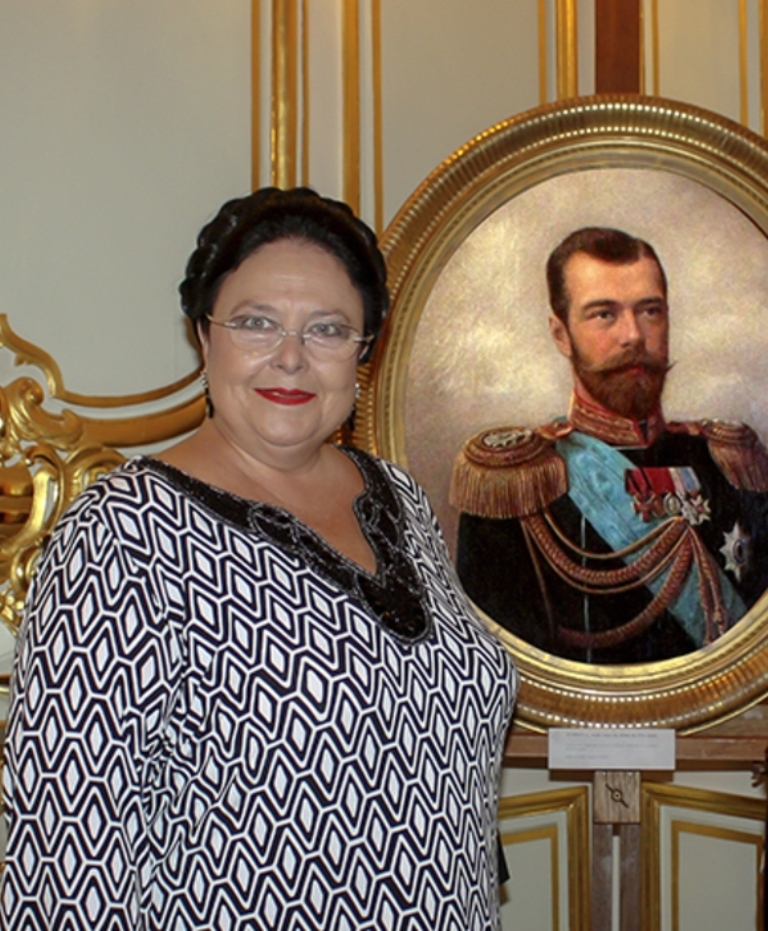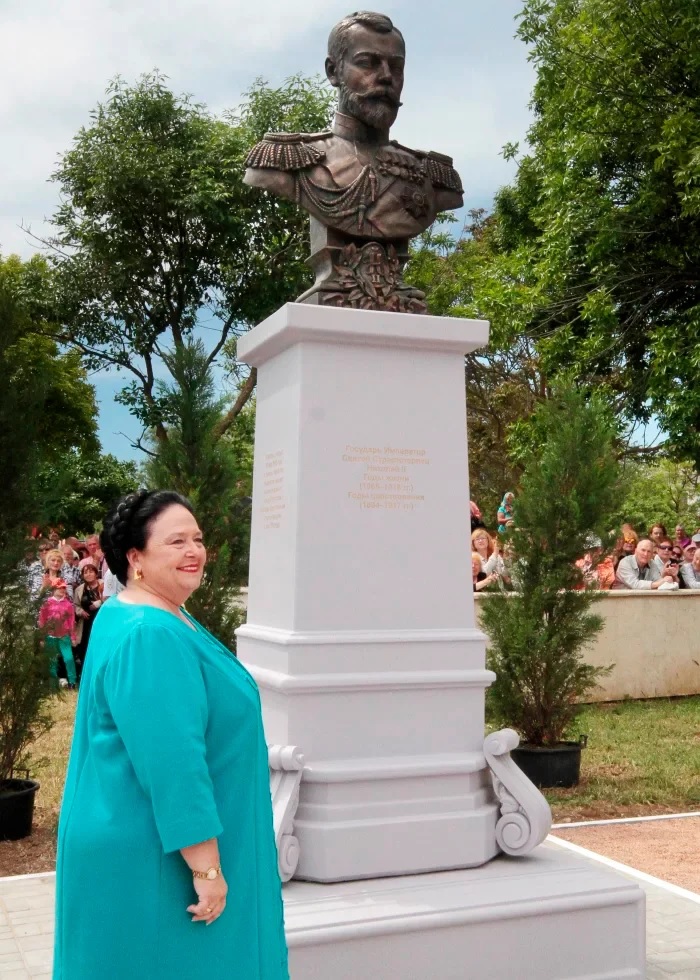
Grand Duchess Maria Vladimirovna poses near a portrait of Nicholas II
In 2016, the Head of the Russian Imperial House HIH Grand Duchess Maria Vladimirovna graciously consented to an interview with Paul Gilbert, Editor of the semi-annual journal Royal Russia, in which she speaks candidly on a wide range of topics on the past, present and future of the Russian Imperial House..
Of particular interest to adherents to Russia’s last emperor and tsar, are the following excerpts from the interview pertaining to Nicholas II.
For nearly a century, the last Emperor of Russia, Nicholas II, has been maligned and slandered by Western historians and biographers. In your opinion, how have these historians and authors been mistaken about Nicholas II?
No one can prevent historical figures from being criticized. But one must distinguish objective criticism from slander and defamation. Both positive and negative assessments must be supported by evidence that emerges from the careful study and analysis of historical sources.
We are all judged by the fruits of our actions. Russia in the reign of Emperor Nicholas II grew in population by 150% and its rate of economic growth was the highest in the entire world. Labour laws in Russia were among the most progressive anywhere, which was acknowledged even by President Taft of the United States. The great Russian academic Dmitrii Mendeleev, the French economist Edmond Teri, and other researchers have written about the strength and development of Russia in these years and have shown that Nicholas II actually achieved a lot for his country during his reign.
Some might say that because the reign of Nicholas II ended in revolution, any accomplishments he may have had lose their value and meaning. But that’s not the right way to look at it.
I think you would agree that, if a driver is unable to prevent a grenade from going off in his car, it doesn’t mean that he was a bad driver or that the car had some defect or had been poorly constructed or hadn’t been maintained in good working condition.
Absolutely—Emperor Nicholas II, like any human being or statesman, was not without sin and certainly did make mistakes.
But he was a man of deep faith, a great patriot, an honourable, genuine, and humane man, who with courage and integrity bore all the hardships that fate had delivered to him, both during his reign and afterward.
In canonizing him as a passion-bearer, the Holy Church affirmed that Emperor Nicholas II was one of the principal moral guides of our people. And I believe that this decision by the hierarchy of the Church resonates in the hearts of my countrymen.
Thus while I certainly do not deny the right of historians to debate the correctness or mistakes on this or that decision made by Emperor Nicholas II, I cannot condone those who try to blacken his memory or depict him as a dull and shallow-minded man who cared only about his family.
There is simply no substantiation in the historical sources for that view of him.

Grand Duchess Maria Vladimirovna at the monument to Nicholas II in Evtaporia, Crimea
In your view, why is the rehabilitation of the Tsar-Martyr Emperor Nicholas II by the Supreme Court of the Russian Federation so important for a proper understanding of Russian history?
Some misunderstand the meaning of the word “rehabilitation,” thinking that it connotes a kind of “amnesty.”
In point of fact, however, the rehabilitation of the victims of political repression is a recognition that such people were the targets of illegal action perpetrated in the name of the government and that these actions be deemed formally by the government today as illegal and the victims be recognized as having being entirely innocent and have their honour, integrity, and good name fully and legally restored to them.
For the Russian government today, the rehabilitation of the Holy Royal Passion-Bearer Emperor Nicholas II, his family, other murdered members of our House, and their faithful physician and attendants, has an enormous legal and moral significance.
The Russian Federation is the legal successor of the Russian Soviet Federated Socialist Republic—the RSFSR—and of the Union of Soviet Socialist Republics—the USSR.
A local governmental organ, which exercised full political authority at that time—the Ural Soviet of Workers’ and Soldiers’ Deputies—passed a death sentence on the Emperor, his family and their servants, and the supreme governmental organs of Soviet Russia—the All-Russian Central Executive Committee and the Soviet of People’s Commissars—recognized this decision as correct and approved it.
Until 2008, the Presidium of the Supreme Court of the Russian Federation had not ruled on my petition for the rehabilitation of the Royal Martyrs, and so from a legal point of view the executions continued to be considered lawful and justified.
Neither the canonization of the Royal Family by the Church nor the statements from various leaders of the country condemning the murders carried any legal weight. So we had a situation where the Church and the faithful considered Nicholas II and his family saints, many others of our countrymen considered them, if not saints, at least as innocent victims of terror, and the government? It saw them as criminals deserving of death.
Of course, that was an absurd and unsustainable situation—and a bloody burden from which the government needed to free itself.
Thank God, the highest court in the land concurred with the arguments I presented and finally made the correct and legal ruling on the matter.
I would especially like to acknowledge and thank the Chief Justice of the Supreme Court, Vyacheslav Lebedev, for his part in reaching this ruling. He delved deeply into the matter and put an end to this on-going violation of the law. Before the ruling came down on October 1, 2008, rehabilitating the murdered members of the Imperial Family, we did not know him at all or what he thought about our legal arguments or about us in general. But he researched the question on his own and agreed with my petition on its merits, issuing his ruling “On the Rehabilitation of the Victims of Political Repression” entirely on the basis of the historical facts alone.
This ruling on the rehabilitation of the Imperial Family, their relatives and faithful servants, all murdered by the atheistic and totalitarian Communist regime, is perhaps one of the best pieces of evidence that Russia has undergone a colossal positive change in its understanding of the country’s past and has made important strides forward in the defense of human rights today.
* * *
The interview was published in the No. 11 issue of Royal Russia in January 2017. The 19 page interview, features 15 black and white photographs, courtesy of the Russian Imperial House.
Grand Duchess Maria Vladimirovna speaks candidly on a wide range of topics on the past, present and future of the Russian Imperial House.
These include memories of her parents, Grand Duke Vladimir Kirillovich and Grand Duchess Leonida; the alleged treason by her grandfather Grand Duke Kirill Vladimirovich in the wake of the 1917 Revolution; the rehabilitation of Emperor Nicholas II in 2008; her relationship with the Russian Orthodox Church in post-Soviet Russia; the new investigation of the Ekaterinburg remains; the reunification of Crimea with the Russian Federation, the situation in Ukraine – and numerous other topics.
© Paul Gilbert. 21 February 2020

You must be logged in to post a comment.